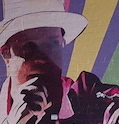| At The Hundredth Meridian references | ||
|
"...At the Hundredth meridian Where the great plains begin" The one hundredth meridian is the line of longitude that separates much of Western Canada from the Central and Atlantic regions. The line also serves as a division between the moist and urban east and the arid and rural west. It has also come to provide a convenient political dividing line (sort of the Canadian equivalent to those familiar Blue and Red States) between the liberal leaning east and conservative leaning west. "...Driving down a corduroy road"Corduroy roads have two connotations in Canadian history. The term has been used to describe dirt roads, common of course in the settlement of the west, being imprinted by the wooden wheels of wagon trains and convoys as they rolled into town. This would leave long straight lines in the dust, making a stretch of road look rutted like corduroy. The second connotation, more popular and better known, refers to attempts to make difficult roads more passable. Planks of wood or full logs would be laid across dirty or muddy roads. This was done to ensure wheels could roll over the wood and avoid being stuck in the mud or slowed by poor road conditions. The incongruous wood resembled corduroy. From Ron Brown's Unusual Ontario: "to allow wagons and horses to cross low-lying areas, which were bogs during spring, logs were laid side by side. The effect resembled the ridged cloth preferred by European royalty, and they were named "corduroy" or "cords-du-roi" roads." A Hip Head from Sidney, British Columbia has this to add: When I was a teenager my school was the first "group" to hike the perimeter of the Hesquiat Peninsula on the west coast of Vancouver Island. Along our way we encountered and walked several miles on what we were told were "Corduroy Roads." To describe them, there were quite a few miles of (in sections) roads on our trail that were built right along the waters' edge that were made of large timbers comparable to railroad ties but longer. They were built for the sole purpose of allowing logging trucks of old to travel along the beach to collect the trees that were cut down by the fallers working uphill from the beach. They were to the best of my memory (this is 23 years ago for me) made by the pairing of two of these large timbers (12" x 12" perhaps) on either side with the under-structure looking a lot like an old wooden railroad bridge, but right at the edge of the ocean at only 3 to 5 feet above the surface of the water. The coastline where they were located was mostly crushed rock (average size of the rocks was about the same as a basketball). We were told by the fellow (a resident logger) that went ahead and marked the path for our trip by means of tactfully placed red ribbons that these wonderful structures we would encounter and utilize for ease of travel were in fact "Corduroy Roads.""...I remember Buffalo, I remember Hengelo" Two incidents from Hip lore provide the inspiration for this lyric. The reference to Buffalo remains largely a mystery, while the Hengelo gig is now a legendary bootleg. For many years the conventional wisdom held that the lyric was inspired by a shoe-throwing incident at a Hip show in Buffalo, New York. Many a heated debate was had over at hipbase.com in 2005 when I first went digging around researching this reference. But, many then, and Hip Head Ian Durham now, claim to have been at that show, and it was definitely in 1993. So, it happened after the release of this record and can't possibly be the story behind this lyric. At the infamous 1993 Buffalo show, a shoe hit Gord, he walked off stage and the rest is Hip history. So, if you know of any other Buffalo lore, let me know. The boys played there many times before 1991. Buffalo could have been used simply because it rhymes with Hengelo. Or... it's the animal roaming the plains near the 100th Meridian. Hip Head Michael from Buffalo sent this along from near the street where he lives. Nicely done, Buffalo. You remembered Gord, too.
The second incident referenced is great because not only is the story a keeper, but the aftermath was caught on tape. During a tour of the Netherlands in the early 90's the Hip's tour manager, Dave Powell, got lost attempting to drive the boys to their show in Hengelo. As Powell attempted to navigate the van around the narrow and unmarked European streets, the band members sat in the back and drank. The more lost Dave became, the more drunk the band became. The bootleg recording of the Hengelo show is an entertaining one-of-a-kind. Although the boys play like mad, it's obvious from Downie's inter-song soliloquies that he's tragically ripped. "...Get Ry Cooder to sing my eulogy"Ryland Peter Cooder was born in 1947 and is already a genuine blues legend. He began playing guitar at age 3 and has since recorded vaunted albums such as "Chicken Skin Music" and "The Buena Vista Social Club." The BBC described him as a "blues guitar guru, session man, scorer of films, champion of world music and all round good guy. Since the mid-60s he has shown an unbounded enthusiasm for playing his instrument in as many styles as he can find. A musician's musician." |